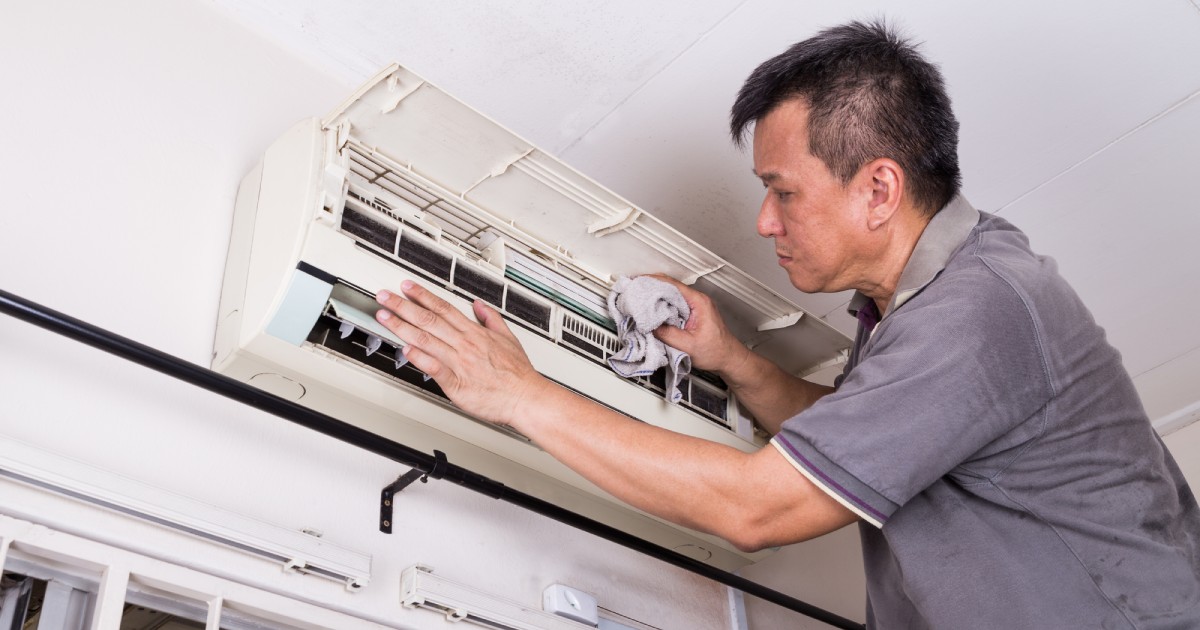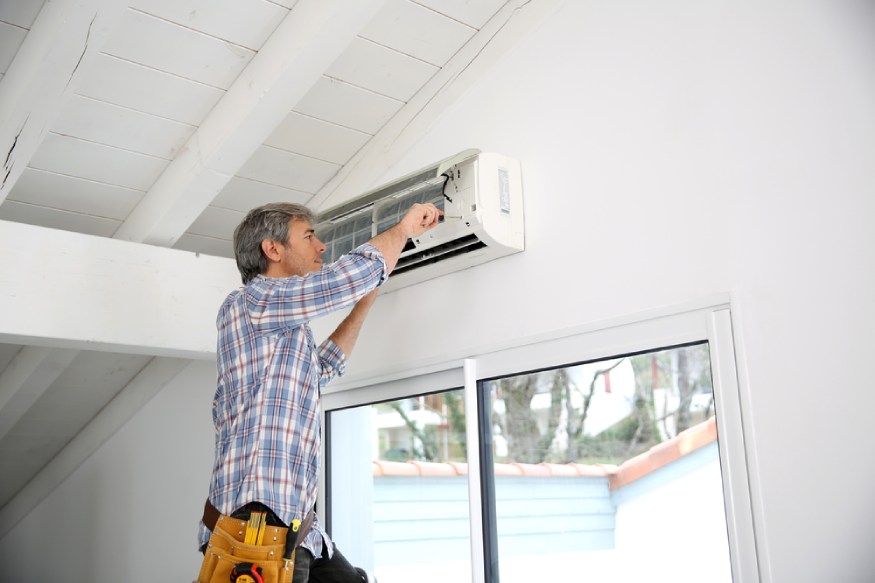As a homeowner, you may have heard that you should get a unit with a higher CFM rating to ensure proper cooling, especially if you go up in tons. But what does that mean for your home, and how many CFMs do you need per ton?
For the best cooling performance, your air conditioner should have 400 CFM per ton of cooling in most cases (sometimes you need more and sometimes less, depending on humidity). For example, if you have a 4-ton AC unit, you should have 1600 CFMs.
This article will cover what CFMs and “tons” are and thoroughly explain how many CFM per ton of cooling you need. So, keep reading to learn more!

What Does CFM Mean for Air Conditioning?
CFM stands for cubic feet per minute. It’s a unit of measurement that tells you how much air an air conditioner can move in one minute. The higher the CFM, the more air moved, and vice versa.
Sometimes, people think a higher CFM means better cooling performance. And while this is partially true, it doesn’t tell the whole story.
Your AC unit needs to do two things to cool your home properly — remove heat and humidity. If your AC unit can move a lot of air but doesn’t have the power to remove heat effectively, it will not do a good job at cooling your home.
The key is finding an AC unit with the right balance of CFM and cooling power. Cooling power is measured in tons or British Thermal Units (BTUs) — 1-ton equals 12,000 BTUs.
How Many CFMs Does My AC Unit Need?

Now that we’ve explained what CFMs are and how they work with your AC unit, you’re probably wondering how many CFMs you need for proper cooling.
The answer isn’t as simple as a certain number of CFMs per ton of cooling. The fact is, there are a lot of factors that come into play when choosing the right AC unit for your home.
Some of these factors include:
- The size of your home
- The climate you live in
- The level of humidity in your home
- Your home’s insulation
That said, there are general guidelines you can follow to get an idea of how many CFMs you need. In most cases, you’ll want an AC unit with 400 CFM per ton of cooling. So, if you have a 4-ton unit, you should have 1600 CFMs.
Of course, as we mentioned before, there are cases where you’ll need more or less CFMs. For example, if you live in a hot and humid climate, you may want an AC unit with 450 CFM per ton to ensure proper cooling.
On the other hand, if your home is well insulated and doesn’t lose heat quickly, you may get away with 350 CFM per ton.
The best way to know how many CFMs you need is to talk to an HVAC technician. They can assess your home and make recommendations based on your specific needs.
How Many CFMs You Need For Every AC Unit Size
You can use the table below to determine how many CFMs you will need for your AC unit size. When you purchase a new air conditioning system, you can also ask the HVAC contractor for their recommendation on what will be best for your home.
| Unit Tonnage | BTUs | CFM (Humid Climates) | CFM (Moderate Climates) | CFM (Dry Climates) |
| 1 | 12000 | 300 | 400 | 500 |
| 1.5 | 18000 | 450 | 600 | 750 |
| 2 | 24000 | 600 | 800 | 1000 |
| 2.5 | 30000 | 750 | 1000 | 1250 |
| 3 | 36000 | 900 | 1200 | 1500 |
| 4 | 48000 | 1200 | 1600 | 2000 |
| 4.5 | 54000 | 1350 | 1800 | 2250 |
| 5 | 60000 | 1500 | 2000 | 2500 |
| 5.5 | 66000 | 1650 | 2200 | 2750 |
| 6 | 72000 | 1800 | 2400 | 3000 |
Note: The above table uses 300 CFM per ton for humid climates, 400 CFM per ton for moderate climates, and 500 CFM per ton for dry climates.
Why Do You Need Less CFM for Humid Climates?

One common question we get is why you need less CFM per ton of cooling in humid climates. After all, shouldn’t you need more CFMs to cool the air?
The answer has to do with how your AC unit removes humidity from the air. You see, when your AC unit cools the air, it also removes some moisture. Cooler air holds less moisture than warmer air, so its latent heat is lower.
The AC removes moisture from the air in a process called dehumidification, which is an integral part of the cooling process. In fact, it’s just as important as removing heat from the air.
Note: In humid climates, your AC unit must work harder to remove the moisture and heat from the air. This means it doesn’t have to move as much air to cool your home effectively. Of course, this is just a general rule of thumb. The best way to know how many CFMs you need is to talk to a professional.
Why Do You Need More CFM for Dryer Climates?
You might also wonder why you need more CFM per ton of cooling in dry climates. After all, shouldn’t the air be easier to cool in these areas? It actually isn’t. If you guessed that it’s because dryer air has higher latent heat than cooler air, you’re exactly right.
To put it simply, dryer air is harder to cool. When the air is dry, your AC unit can’t remove as much moisture, making it harder to extract heat from the air. This means it has to focus more on removing the heat, which is why you need more CFMs.
3 Reasons You Might Need More CFMs

In some cases, you might need more CFMs than the general rule of thumb. Here are three reasons why you might need more CFMs:
1. You Have a Large Home
If you have a large home, you will need more CFMs to cool it properly. That’s because your AC unit will have to move a lot of air to cool all the rooms in your home. Conversely, if you live in a small home, you will not need as many CFMs.
2. You Have Poor Insulation
If your home has poor insulation, it will lose heat more quickly, and your AC unit will work harder to cool your home. Air gaps in your doors and windows, minimal insulation in your attic, and low-quality insulation in your exterior walls will require a higher CFM AC unit to keep your home cool.
If you have a well-insulated home, you will need fewer CFMs per ton of cooling capacity.
3. You Live in a Hot and Humid Climate
As we mentioned before, if you live in a hot and humid climate, your AC will need more CFMs to remove the moisture from the air. For 50% or lower humidity levels, you’ll need 500 to 600 CFM per ton.
What Are the Consequences of Not Having Enough CFMs?
Now that you know how many CFMs you should have per ton of cooling, you might be wondering what happens if you don’t have enough.
If your AC unit doesn’t have enough CFMs, it won’t be able to move the air through your home quickly enough. This will lead to several problems, including:
- Poor cooling performance
- Hot and stuffy rooms
- High energy bills
- Short-cycling (your AC unit turns on and off frequently)
- Increased frequency of breakdowns and repairs
- Reduced lifespan for your AC unit
In short, not having enough CFMs can cause a lot of problems for your home and budget. That’s why ensuring you have the right amount of CFMs for your specific needs is important.
Enough CFMs Means Better Comfort
You should have 400 CFMs per ton of cooling in most cases. This will ensure proper cooling for your home. However, there are some instances where you may need more or less CFMs.
If you’re unsure how many CFMs you need, the best thing to do is talk to an HVAC professional. They can help you choose a suitable AC unit for your home and ensure you have the proper CFM rating.
Having the right amount of CFMs is essential for comfort in your home. But it’s also crucial for the longevity of your AC unit. So, make sure you have enough CFMs to keep your home cool and comfortable all summer long!
Never had a chance to learn this staff while at college though am in the HVACR trade. Am sure this knowledge will help me as I am on quest to figure out the right size of a aircon. Thanks so much sir.